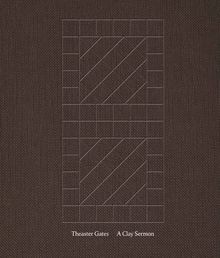| |||||||||||||||||||||||||
ARTIST MONOGRAPHS
|
|
STATUS: Forthcoming | 2/3/2026 This title is not yet published in the U.S. To pre-order or receive notice when the book is available, please email orders @ artbook.com |
 Theaster Gates: Black Chapel
Theaster Gates: Black Chapel
Serpentine Pavillon 2022
Published by Walther König, Köln.
Edited by Chris Bayley, Natalia Grabowska, Yesomi Umolu. Text by David Adjaye, Jayden Ali, Jareh Das, Ryan Dohoney, Theaster Gates, Hans Ulrich Obrist, Christina Sharpe.
This volume encompasses the 2022 Serpentine Pavilion Commission Black Chapel by American Chicago-based artist Theaster Gates (born 1973). Richly illustrated and arranged by acclaimed designer Joseph Logan, this book documents the pavilion’s existence through the summer season, inhabited by live events from experimental music to spiritual workshops. Photographs of this “space of deep reflection” highlight Gates’ seven tar paintings produced for the installation, as well as the bronze bell sourced from a Chicago Catholic church placed outside to mark performances. Supplementing the images is new writing from architects, artists and musicians reflecting on Gates’ pavilion. Inspirations compiled by the artist of places, buildings, objects and rituals, alongside documentation of his own past projects, add insight into the installation’s design process.
PUBLISHER
Walther König, Köln
BOOK FORMAT
Paperback, 8 x 11 in. / 240 pgs / 45 color / 80 bw.
PUBLISHING STATUS
Pub Date 1/9/2024
Active
DISTRIBUTION
D.A.P. Exclusive
Catalog: SPRING 2024 p. 28
PRODUCT DETAILS
ISBN 9783753303826 FLAT40
List Price: $39.95 CAD $56.95
AVAILABILITY
In stock
in stock $39.95 Free Shipping UPS GROUND IN THE CONTINENTAL U.S. |
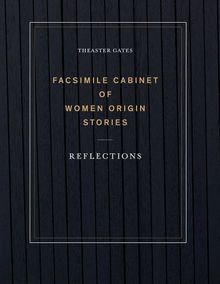 Theaster Gates: Facsimile Cabinet of Women Origin Stories
Theaster Gates: Facsimile Cabinet of Women Origin Stories
Reflections
Published by DelMonico Books.
Edited by Daisy Desrosiers. Introduction by Theaster Gates. Contributions by Krista Aronson, Dorothy Berry, Danielle M. Conway, Elizabeth Finch, Cheryl Townsend Gilkes, Lareese Hall, Lynn McKinley-Grant, Erin Murphy, Asma Naeem, Ellen Y. Tani, Arisa White, Briana Williams.
Published with Colby College Museum of Art.
This book features essays and other reflections commissioned in response to the Facsimile Cabinet of Women Origin Stories, a monumental participatory work by Theaster Gates (born 1973). The Cabinet includes nearly 3,000 framed images of women from the Johnson Publishing Company archive, and highlights from the collection appear in this edited volume.
Founded in 1942, Chicago-based Johnson Publishing chronicled the lives of Black Americans for more than seven decades through the magazines Ebony and Jet. Composed from arguably the most important archive of American Black visual culture in the 20th century, Gates’ work centers the essential and too often unsung role of women in this history.
When the Cabinet was exhibited at the Colby College Museum of Art, 12 women from a wide range of disciplines (including archivists, legal scholars, anthropologists and librarians, as well as curators, visual artists, filmmakers, writers and art historians) were invited to reflect on a work that brings a sisterhood of images to light.
PUBLISHER
DelMonico Books
BOOK FORMAT
Paperback, 7.25 x 9.25 in. / 144 pgs / 6 color / 60 bw.
PUBLISHING STATUS
Pub Date 12/21/2021
Active
DISTRIBUTION
D.A.P. Exclusive
Catalog: FALL 2021 p. 113
PRODUCT DETAILS
ISBN 9781636810089 TRADE
List Price: $24.95 CAD $33.95 GBP £19.00
AVAILABILITY
In stock
in stock $24.95 Free Shipping UPS GROUND IN THE CONTINENTAL U.S. |
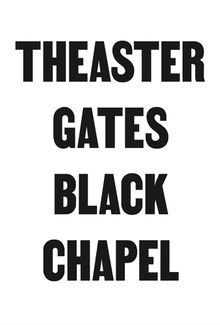 Theaster Gates: Black Chapel
Theaster Gates: Black Chapel
Published by Walther König, Köln.
Edited by Anna Schneider. Text by Guthrie P. Ramsey, Jr., Dimona Stöckle. Conversation with Hamza Walker.
Guided by the forms of solidarity found within Black communities, American artist Theaster Gates (born 1973) creates visionary installations that transform public spaces into places of artistic and cultural intervention. In Black Chapel, Gates explores recent German and American history through the life of the great African American athlete Jesse Owens. In this expansive exhibition, Gates responds directly to the architecture of Haus der Kunst’s massive Middle Hall, exposing it to a complex and politically charged narrative. Alongside Owens’ complete and fully illustrated record collection being made available for the first time, the exhibition consists of several large pavilions containing sculptures, photographs and documents, as well as huge illuminated rotating panels displaying photographs from the archives of Ebony and Jet, two magazines that contributed significantly to the dissemination of Black culture in the United States. This interplay of sculpture and photography interrogates Black history, spirituality and representation, and recasts them visually.
PUBLISHER
Walther König, Köln
BOOK FORMAT
Paperback, 7.5 x 11 in. / 176 pgs / 1550 color / 38 bw.
PUBLISHING STATUS
Pub Date 11/9/2021
Out of stock indefinitely
DISTRIBUTION
D.A.P. Exclusive
Catalog: SPRING 2022 p. 32
PRODUCT DETAILS
ISBN 9783960988540 FLAT40
List Price: $55.00 CAD $75.00
AVAILABILITY
Not available
STATUS: Out of stock indefinitely. |
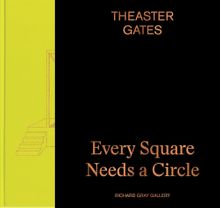 Theaster Gates: Every Square Needs a Circle
Theaster Gates: Every Square Needs a Circle
Published by GRAY.
Text by Theaster Gates, Zachary Cahill.
In Every Square Needs a Circle, Theaster Gates (born 1973) offers a rumination on Black economies and empire building, relating to moments from art history and stories of quotidian labor. Produced on the occasion of his first exhibition in his native Chicago in over five years, Every Square Needs a Circle offers a detailed look at the artist’s sculpture, tar paintings, installation and neon work. Gates debuts a multifaceted installation that bridges the work of W.E.B. Du Bois with architectural excerpts from Chicago, placing his interest in the history of objects while expounding on the archives that hold records of Black intelligence.
The book features an introductory poem by Theaster Gates, an essay by Chicago artist Zachary Cahill and 112 color illustrations.
PUBLISHER
GRAY
BOOK FORMAT
Slip, clth, 9.5 x 12 in. / 144 pgs / 48 color.
PUBLISHING STATUS
Pub Date 4/7/2020
Out of stock indefinitely
DISTRIBUTION
D.A.P. Exclusive
Catalog: SPRING 2020 p. 123
PRODUCT DETAILS
ISBN 9780996454049 TRADE
List Price: $65.00 CAD $92.00 GBP £57.00
AVAILABILITY
Not available
STATUS: Out of stock indefinitely. |
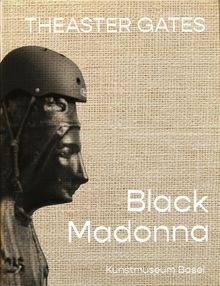 Theaster Gates: Black Madonna
Theaster Gates: Black Madonna
Published by Walther König, Köln.
Edited by Josef Helfenstein, Daniel Kurjakovic. Text by Elvira Dyangani Ose, Theaster Gates, Daniel Kurjakovic.
For his Kuntsmuseum Basel exhibition, Chicago-based multiartist Theaster Gates (born 1973) interrogates the mainstream art world’s Eurocentrism through a multi-venue, multimedia exploration of the figure of the Black Madonna.
A self-described “collector of collections,” Gates draws upon his vast arsenal of interdisciplinary talents and personal archives to highlight the Black Madonna’s presence in religion and art history. Including a printing workshop and performances by the artist’s band, the Black Monks, this many-faceted program is as much a site of creation and conversation as it is one of critical engagement.
This clothbound publication serves as an accompaniment to the exhibition and delves into Gates’ methods, featuring pictorial reportage and new essays that highlight a number of complexities related to spirituality, Black identity, and artistic and political agency.
PUBLISHER
Walther König, Köln
BOOK FORMAT
Clth, 7 x 9 in. / 188 pgs / 200 color.
PUBLISHING STATUS
Pub Date 4/14/2020
Out of stock indefinitely
DISTRIBUTION
D.A.P. Exclusive
Catalog: FALL 2020 p. 109
PRODUCT DETAILS
ISBN 9783960987246 FLAT40
List Price: $55.00 CAD $77.00
AVAILABILITY
Not available
STATUS: Out of stock indefinitely. |
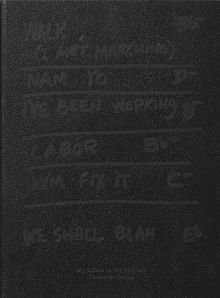 Theaster Gates: My Labor Is My Protest
Theaster Gates: My Labor Is My Protest
Published by White Cube.
Edited by Honey Luard. Text by Bill Brown, Fred Moten, Jacqueline Terrassa.
PUBLISHER
White Cube
BOOK FORMAT
Hardcover, 8.5 x 11.5 in. / 172 pgs / 107 color / 11 bw.
PUBLISHING STATUS
Pub Date 7/31/2013
Out of print
DISTRIBUTION
D.A.P. Exclusive
Catalog: SPRING 2013 p. 113
PRODUCT DETAILS
ISBN 9781906072599 TRADE
List Price: $75.00 CAD $90.00
AVAILABILITY
Not available
STATUS: Out of print | 00/00/00 For assistance locating a copy, please see our list of recommended out of print specialists |
 Theaster Gates: 12 Ballads for Hugenot House
Theaster Gates: 12 Ballads for Hugenot House
Published by Walther König, Köln.
Foreword by Carolyn Christov-Bakargiev, Madeleine Grynsztejn. Text by Michael Darling, Theaster Gates, Matthew Jesse Jackson, John Preus. Conversation with Carolyn Christov-Bakargiev.
PUBLISHER
Walther König, Köln
BOOK FORMAT
Clth, 7.75 x 10.75 in. / 128 pgs / 103 bw.
PUBLISHING STATUS
Pub Date 10/31/2012
Out of print
DISTRIBUTION
D.A.P. Exclusive
Catalog: SPRING 2013 p. 113
PRODUCT DETAILS
ISBN 9783863352035 TRADE
List Price: $59.95 CAD $79.00
AVAILABILITY
Not available
STATUS: Out of print | 00/00/00 For assistance locating a copy, please see our list of recommended out of print specialists |
